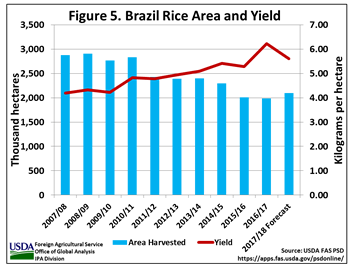Planting of Summer Crops Begins in Brazil
Brazil’s 2017/18 summer crop cycle is beginning, while the harvest of remaining corn and cotton crops concludes the bumper 2016/17 season. During the exceptional 2016/17 season, characterized by plentiful and well-distributed rainfall with adequate solar radiation, both soybean and corn production reached unprecedented levels and record yields were attained for the summer crops (corn, soybean, rice and cotton). The planting of summer crops generally coincides with the onset of seasonal rains. The planting of first-crop corn and rice has begun. Soybean planting gets underway in the latter half of September and cotton planting begins in October.
Soybeans
Brazil is the world’s second-largest soybean producer, with a record soybean crop of 114 million metric tons (mmt) in 2016/17 from a record area of 33.9 million hectares (mha). The 2016/17 growing season’s favorable weather, together with improved seed varieties and crop management practices, contributed to record soybean yields. During the past 10 years, soybean area has increased 60 percent. Despite the abundant supplies from last year’s record soybean crop, soybeans remain the better alternative to first-crop corn because of higher financial returns. Therefore, area is forecast to increase again for 2017/18 (to 37.5 mha), up 2 percent from the previous year. Production is forecast at 107 mmt with a yield of 3.08 mt/ha, down 8 percent from last year’s record. Planting of the 2017/18 soybean crop begins mid-September in the central and southern regions, where the majority of the crop is grown (Figure 1).

Corn
Brazil is the world’s third-largest corn producer, after the United States and China, and has two seasons for corn production. The first crop is grown predominantly in the southern and northeastern states. The second (safrinha) crop, historically smaller than the first crop, has steadily increased in size each year and now comprises more than two-thirds of Brazil’s corn production. Safrinha corn is grown predominantly in the Center-West region and the southern state of Parana. First-crop yields in 2016/17 were at record levels due to favorable weather. Likewise, second-crop yields benefited from continued favorable weather, including an extended rainy season. The second-crop harvest recently concluded and total corn production for 2016/17 is estimated at 98.5 mha with a record yield of 5.61 mt/ha. In the past 10 years, total area planted to corn has increased 19 percent. With second-crop corn planted to only about a third of the soybean crop area that precedes it, and with soybean area continuing to rise, the potential exists for continued growth in second-crop corn area. Mato Grosso is the leading contributor to growth in corn area, accounting for 38 percent of all second-crop corn area according to government sources (Figure 2). Brazil corn area in 2017/18 is estimated at 17.7 mha, up 1 percent from the previous year, with production forecast at 95 mmt. Planting of first-crop corn is underway, and planted area is forecast to decrease given the large supply and low prices realized from the previous bumper corn crop. Harvesting of the first crop commences in January. The larger second crop is planted after the soybean harvest from January to March.
Storage was a major concern in the 2016/17 season given the bumper harvests of both soybeans and corn. On- and off-farm storage was reportedly filled to capacity and the use of silo bags was widespread (Figure 3). Farmers elected to prioritize storage of soybeans rather than corn in anticipation of higher prices for soybeans.
Rice
Rice is grown mostly in the southern states (82 percent of rice production) with the remainder grown in the central and northern regions (Figure 4). The area planted to rice has steadily declined from a high of 6.5 mha in 1980 to the 2016/17 record low of 1.98 mha, as producers switched to more profitable crops such as soybeans. Despite lower planted area in 2016/17, favorable weather and an increase in irrigated area boosted yield to a record 6.22 mt/ha (rough), and resulted in rough rice production of 12.3 mmt (8.4 mmt on a milled basis). Rough rice production is forecast to decrease in 2017/18 to 11.8 mmt (milled basis), with yield down from the previous year’s record. Area is forecast to rebound from last year’s record low to 2.1 mmt (Figure 5). Rice is planted from September to December and harvested from February through June, although later-planted rice grown in the northeast extends the season to August.
Cotton
Cotton is predominantly produced in two states: Mato Grosso and Bahia (Figure 6). In 2016/17, despite a dry start in Bahia, the cotton crop in both states received favorable weather resulting in good development and high yields. Harvest of the 2016/17 crop continues through September. Production is estimated at 7.0 million bales, up 20 percent from the previous year’s drought-affected crop, and yield is estimated at a record 1,621 kg/ha. The cotton sector is expected to continue its recovery into 2017/18 after several years of declining production due in part to reduced consumption and unfavorable weather. Producers are encouraged by the positive outcome of the 2016/17 season, and cotton area for 2017/18 is forecast at 1.05 mha (Figure 7), up 12 percent from the previous season with production forecast at 7.5 million bales. Yield is forecast at 1,555 kg/ha, down from last season’s record. Planting of cotton begins in October in the south and in November in the central region and Bahia.







Current USDA area and production estimates for grains and other agricultural commodities are available on IPAD's Agricultural Production page or at PSD Online.
Visit Crop Explorer https://www.pecad.fas.usda.gov/cropexplorer/
|

